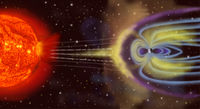
Photo from wikipedia
Abstract This paper presents the response of the ionosphere during the intense geomagnetic storms of October 12-20, 2016 and May 26-31, 2017 which occurred during the declining phase of the… Click to show full abstract
Abstract This paper presents the response of the ionosphere during the intense geomagnetic storms of October 12-20, 2016 and May 26-31, 2017 which occurred during the declining phase of the solar cycle 24. Total Electron Content (TEC) from GPS measured at Indore, Calcutta and Siliguri having geomagnetic dips varying from 32.23°N, 32°N and 39.49°N respectively and at the International GNSS Service (IGS) stations at Lucknow (beyond anomaly crest), Hyderabad (between geomagnetic equator and northern crest of EIA) and Bangalore (near magnetic equator) in the Indian longitude zone have been used for the storms. Prominent peaks in diurnal maximum in excess of 20-45 TECU over the quiet time values were observed during the October 2016 storm at Lucknow, Indore, Hyderabad, Bangalore and 10-20 TECU for the May 2017 storm at Siliguri, Indore, Calcutta and Hyderabad. The GUVI images onboard TIMED spacecraft that measures the thermospheric O/N2 ratio, showed high values (O/N2 ratio of about 0.7) on October 16 when positive storm effects were observed compared to the other days during the storm period. The observed features have been explained in terms of the O/N2 ratio increase in the equatorial thermosphere, CIR-induced High Speed Solar Wind (HSSW) event for the October 2016 storm. The TEC enhancement has also been explained in terms of the Auroral Electrojet (AE), neutral wind values obtained from the Horizontal Wind Model (HWM14) and equatorial electrojet strength from magnetometer data for both October 2016 and May 2017 storms. These results are one of the first to be reported from the Indian longitude sector on influence of CME- and CIR-driven geomagnetic storms on TEC during the declining phase of solar cycle 24.
Journal Title: Advances in Space Research
Year Published: 2020
Link to full text (if available)
Share on Social Media: Sign Up to like & get
recommendations!